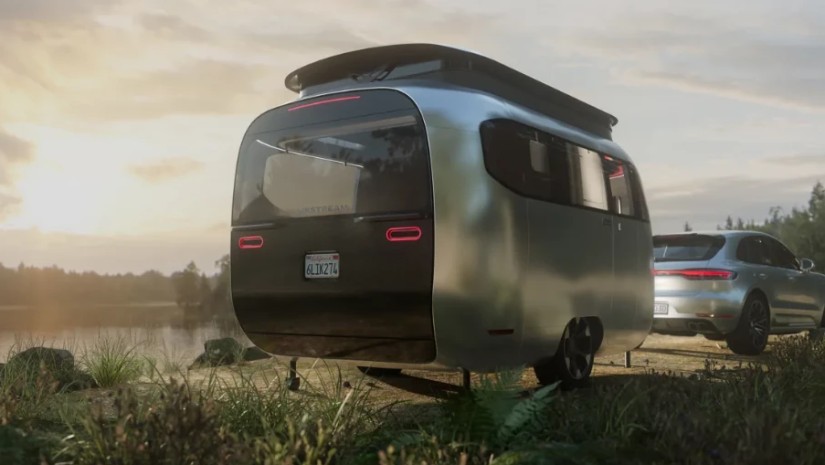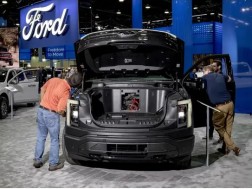One sound could go missing from the symphony that greets campers at dawn. Besides bird chirps, owl hoots and racoons searching for food, the rumble of car engines firing up as campers head home may be strangely absent.
It will at least be less common as electric trucks and SUVs start arriving at more campsites. While still a small minority, campers are more likely to own an electric vehicle than those who don’t go camping, according to a survey by Kampgrounds of America, the nation’s largest campground operator. Only about 1% of Americans currently have an electric vehicle, according to KOA, but about 4% of regular campers do. People who use them extoll their virtues while expressing the need for some infrastructure improvements out in America’s vast open spaces.
Meanwhile, trailer companies are working to make their products easier to tow while EV makers are trying to make the whole experience better, from camping to charging.
Towing worries
Electric motors have distinct advantages when it comes to towing camper trailers. They can pull strongly at low or high speeds, without straining or needing to shift gears.
“I’m not constantly sitting there watching transmission temps climb, I’m not watching motor temps climb on hills, and we live in the [Texas] Hill Country,” said Matt Linn, who goes camping with his Ford F-150 Lightning and a camper trailer every few weeks.
One major concern campers share when towing with an EV, of course, is range. Any vehicle – whether powered by gasoline, diesel fuel, or electricity – will lose significant driving range between refills when towing a trailer. But liquid fuel tanks are quicker to refill than battery packs and pumps are easier to find than chargers.
Linn says his truck can go roughly half as far on one charge as it usually does when pulling his Rockwood Mini Lite trailer. That still leaves him with more than 150 miles of driving range, though, which puts the campsites he frequents easily within reach without needing a charging stop.
Aerodynamics
Mike Kowal, who goes camping with an Airstream trailer pulled by his Rivian SUV, said his R1S automatically adjusts the range estimates it displays because it learns how the trailer impacts it. It can go up to about 200 miles with the trailer. Still, he said, he learned to be careful when the return trip from a campsite, facing strong headwinds, drained power more quickly than the journey to the campsite had.
“We learned our lesson, a little bit, about cutting it a little close especially when it’s windy,” he said
It’s wind resistance, much more than weight, that pulls down a towing vehicle’s range. Especially at highway speeds, moving a trailer through the air takes more power than pulling its mass.
Thor Industries, the camper and RV manufacturer that owns Airstream and other brands, has been doubling down on aerodynamics research, said McKay Featherstone, the company’s head of product development. They’ve been running models through wind tunnels to find ways to smooth things out, even just a little. Designers and engineers found tricks to, for one thing, keep things like vents and air conditioners from sticking out.
“As we specifically target electric vehicles, it just becomes doubly important,” he said.
Airstream competitor Bowlus, a small ultra-luxury trailer manufacturer known for its shiny bullet-shaped trailers, also emphasizes aerodynamics. Besides that, Bowlus has enough lithium batteries in one of its models that it can be used to charge an electric tow vehicle in an emergency. Another Bowlus trailer can drive itself for short distances – pulling itself into a campsite location – with an on-board electric motor.
“We’ve had customers cross coasts, all the way up to Canada, all the way across Canada and back down, all with an electric vehicle,” said Bowlus CEO Geneva Long.
Plugging in
Charging can also be a major issue, both at campsites and on the road. When he gets to a campsite, Linn said he plugs into the same power outlets that are usually used to provide household power to run lights and small appliances in trailers and RVs.
It’s a controversial move since, technically, those power pedestals aren’t generally designed to charge EVs. Linn said he always asks the campground operator and, so far, has never been declined but he can see why it could become an issue.
“If they’re at 90% capacity and all of a sudden there’s 15 or 20 EV trucks that roll in you could be exceeding the campground’s capacity,” he said. “So, I think that’s a challenge for campground operators that they’re going to have to address.”
KOA is working to install more actual EV chargers while also trying to let campers know that just plugging into those regular outlets might not be OK.
“Particularly, a lot of these campgrounds across the country have older infrastructure that can’t support that,” said Toby O’Rourke, president and chief executive of KOA.
Currently, KOA has dedicated EV chargers at about 5% of its campsites, O’Rourke said, but she thinks that could probably expand to about 50% within the next five to 10 years.
Out on the road, electric truck and EV maker Rivian – which makes vehicles designed to go off-road – is enabling its customers to use Tesla’s charging network, as are most automakers, but it’s also been building out its own network of chargers. That’s because it understands Rivian owners might want to go places other EV owners don’t. So Rivian has been putting chargers in places like Yosemite National Park and along the Blue Ridge Parkway.
The physical layout of most EV chargers can be a challenge for campers. The vast majority of EV chargers are placed at the ends of parking spaces so vehicles have to either pull in, nosing the front bumper up to the charger, or reverse back in. That makes charging with a trailer attached almost impossible or, at best, extremely awkward.
Then there’s the hassle of driving through a parking lot to the charger while towing a trailer, said Sara Eslinger, who’s in charge of Rivian’s charging network.
“We do a lot of studies around turning radiuses and things like that,” she said. “And the goal is that you should not have to unhitch your vehicle at one of our trailer-friendly chargers.”
Powering the campsite
One nice thing about EVs, though, is that they also bring power with them thanks to their hefty batteries. An F-150 Lightning truck, for instance, has 11 power outlets including those in the bed of the truck and in the “frunk” – or front trunk – under the hood.
“We use the frunk almost as an outdoor kitchen because it takes a lot of electrical strain off of the camper to be able to run coffeemakers and ice makers in the frunk,” Linn said.
And he can do it without having to fire up a gas-powered generator, which keeps the campsite a little quieter.
“As more people switch to EVs and go camping and explore, those spaces don’t have to have as much noise pollution,” said Rivian’s Elsinger, who likes to go camping in her own R1T pickup.
Source: CNN















